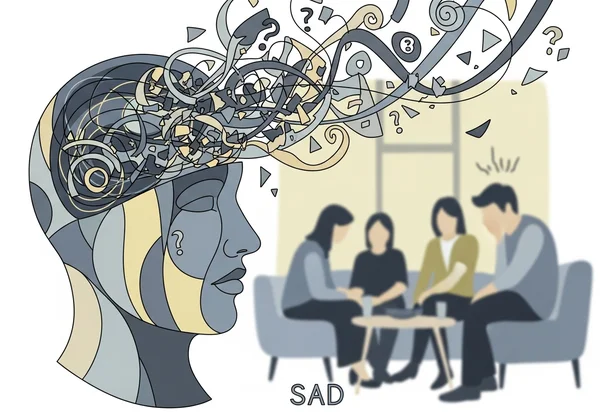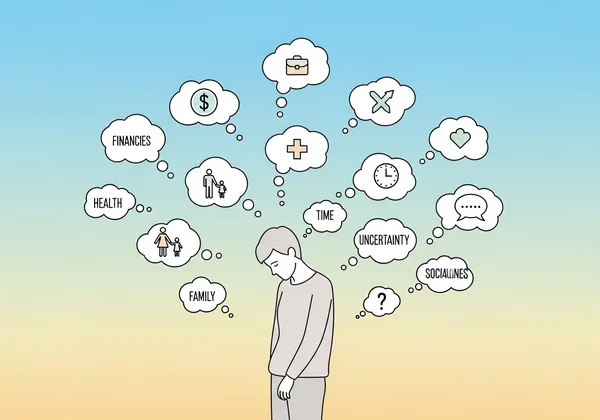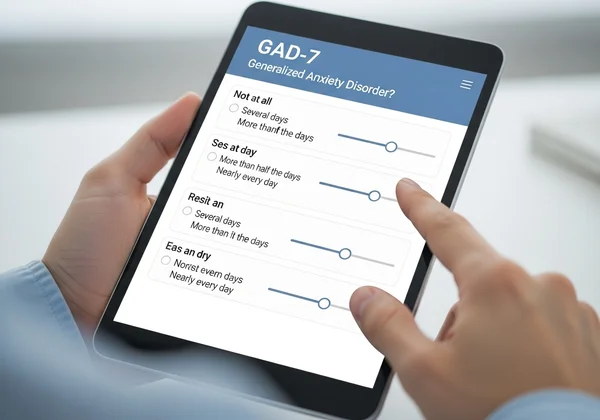Social Anxiety vs. GAD: What Your GAD-7 Score Means
Feeling anxious is a universal human experience. But when worry becomes persistent and overwhelming, it can be confusing to understand its source. You might wonder if your constant unease is just a part of your personality or something more specific. Two common, yet often misunderstood, conditions are Generalized Anxiety Disorder (GAD) and Social Anxiety Disorder (SAD). But how can you tell the difference?
Understanding the nuances between them is a crucial first step toward clarity and effective management. The GAD-7 (Generalized Anxiety Disorder 7-item scale) is a valuable screening tool that can offer initial insights into your symptoms. This article will help you explore the distinctions between GAD and social anxiety and understand what your results from an anxiety screening tool might mean for you.

Understanding Generalized Anxiety Disorder (GAD)
Generalized Anxiety Disorder is characterized by persistent and excessive worry about a variety of different things. If you have GAD, you might find yourself worrying about your health, work, finances, or family, often expecting the worst even when there is no apparent reason for concern. This worry is difficult to control and can interfere significantly with daily life.
The key word here is "generalized." The anxiety isn't tied to one specific situation or trigger; it's a free-floating sense of unease that latches onto various aspects of your life. It's the constant "what if?" that follows you throughout your day.
What is GAD? Unpacking Generalized Anxiety Symptoms
The experience of GAD goes beyond just mental worry. It often manifests physically and behaviorally. Common anxiety symptoms associated with GAD include feeling restless or on edge, being easily fatigued, having difficulty concentrating, irritability, muscle tension, and sleep disturbances. These symptoms are present more days than not for at least six months.
Think of GAD as a constant background hum of anxiety. It may not always be loud, but it’s almost always there, coloring your perceptions and draining your energy.

The GAD-7 Scale: How It Screens for GAD
The GAD-7 is a scientifically validated questionnaire designed to screen for GAD and measure its severity. It asks you to rate how often you have been bothered by seven core symptoms over the past two weeks. These questions focus on feeling nervous, not being able to stop worrying, worrying too much about different things, and trouble relaxing.
This tool provides a numerical score that corresponds to different severity levels—mild, moderate, or severe. It's a quick, confidential way to get an objective snapshot of your recent anxiety levels. To see where you stand, you can take our quick test and get immediate results.
Exploring Social Anxiety Disorder (SAD)
In contrast to GAD, Social Anxiety Disorder, also known as social phobia, involves an intense fear of social situations. This fear is not about general life events but is specifically rooted in the possibility of being watched, judged, or negatively evaluated by others. It's the fear of embarrassing yourself or being seen as awkward, leading to avoidance of social interactions.
While someone with GAD might worry about a party because they fear something bad could happen at the party (like an accident), a person with SAD worries about what people think of them at the party.
Identifying Social Anxiety Symptoms & Fear of Social Situations
The fear of social situations is the hallmark of SAD. This can include anything from public speaking and meeting new people to everyday activities like eating in front of others or making small talk. The anxiety is often out of proportion to the actual threat posed by the social situation.
Physical symptoms can be intense and include blushing, sweating, trembling, rapid heartbeat, and feeling like your mind has gone blank. These symptoms can be so distressing that individuals go to great lengths to avoid the situations that trigger them.

Where SAD Differs from General Worry
The primary difference lies in the trigger. GAD involves widespread worry about numerous aspects of life without a single, consistent trigger. SAD, however, has a very specific trigger: social performance and scrutiny.
A person with SAD may feel perfectly calm and relaxed when they are alone. Their anxiety spikes specifically in anticipation of or during social interactions. For someone with GAD, the feeling of worry is often just as present when they are alone as when they are with others.
Key Distinctions: Social Anxiety vs GAD
Differentiating between these two conditions is key to understanding your own experience. While they can sometimes co-occur, they have distinct core features that set them apart. Pinpointing these differences can help you better articulate your feelings to a healthcare professional.
Getting a baseline understanding of your anxiety can be a powerful first step. A free GAD-7 assessment can provide a starting point for this self-exploration.
The Focus of Your Worry: Specific Social Fears vs. Broad Concerns
The most telling difference is the focus of your anxiety. Ask yourself: What do I spend most of my time worrying about?
- GAD Worry: "What if I lose my job? What if my partner gets sick? What if I fail this exam? What if I can't pay my bills?" The worry is broad, shifting from one real-world concern to another.
- SAD Worry: "What if I say something stupid? What if they think my clothes are weird? What if they see my hands shaking? What if everyone laughs at me?" The worry is specific to social evaluation.
Behavioral Patterns: Avoidance and Coping
How you behave in response to your anxiety also provides clues. Both conditions can lead to avoidance, but what is being avoided is different.
- GAD Behavioral Patterns: A person with GAD might over-prepare, seek constant reassurance, or have trouble making decisions for fear of making the wrong one. They might avoid situations that trigger their specific worries, but the avoidance is as varied as the worries themselves.
- SAD Behavioral Patterns: Someone with SAD will systematically avoid social gatherings, presentations, or any situation that involves performance or interaction. Their world can become smaller as they retreat to avoid judgment.
Your GAD-7 Score and Social Anxiety: What It Tells You
This is an important question. Since the GAD-7 is designed to screen for generalized anxiety, can it tell you anything if your primary issue is social anxiety? The answer is nuanced. Taking the GAD-7 online test is still a useful step, regardless of the source of your anxiety.
Can the GAD-7 Indicate Social Anxiety? Understanding Overlap
Yes, it's possible for someone with significant social anxiety to get a high score on the GAD-7. This is because some questions, like "Feeling nervous, anxious, or on edge" and "Becoming easily annoyed or irritable," are common to many anxiety experiences, including SAD.
However, the GAD-7 does not specifically ask about the fear of judgment or avoidance of social situations, which are the core criteria for SAD. Therefore, it cannot distinguish SAD from GAD. It simply indicates the presence and severity of general anxious feelings.
Interpreting a High GAD-7 Score in the Context of Social Fears
If you take the GAD-7 and receive a moderate or high score, but you recognize that your worries are almost exclusively about social situations, this is valuable information. It suggests that you are experiencing a significant level of anxiety that warrants attention.
Think of the GAD-7 score as a thermometer. It tells you if you have a "fever" of anxiety, but it doesn't tell you the specific "illness" causing it. Your score is a data point that, when combined with your self-reflection about the source of your worries, creates a clearer picture.
Next Steps: Clarifying Your Anxiety and Seeking Support
Understanding the potential source of your anxiety is empowering. It allows you to seek the right kind of support and learn strategies that are tailored to your experience.
Self-Reflection: Is Your Anxiety More Social or Generalized?
After reading this, take a moment to reflect.
- Make a list of the top five things you worry about. Are they mostly social in nature, or do they span different areas of your life?
- Consider the situations you avoid. Are they primarily social events, or are they varied and unpredictable?
- When you feel most anxious, is it usually when you are anticipating interaction with others?
This self-reflection, combined with a tool like the GAD-7, can help you prepare for a conversation with a professional.
When to Seek Professional Help
A self-assessment is a starting point, not a destination. If your anxiety—regardless of its type—is causing you distress or interfering with your relationships, work, or general enjoyment of life, it is a good idea to speak with a doctor or mental health professional.
They can conduct a comprehensive evaluation to provide an accurate diagnosis and discuss effective treatment options, such as therapy (like Cognitive Behavioral Therapy) or medication. Bringing your GAD-7 test results can be a helpful way to start that important conversation.
Taking Control: Understanding Your Anxiety Journey
Distinguishing between Generalized Anxiety Disorder and Social Anxiety Disorder is more than an academic exercise—it's about understanding your unique experience. GAD is characterized by broad, persistent worry across many life areas, while SAD is an intense, specific fear of social judgment.
While the GAD-7 is designed to screen for generalized anxiety, it can still be a valuable tool for anyone experiencing anxiety symptoms. It provides a clear, objective measure of your current distress level, serving as a critical first step on your path to mental wellness.
Knowledge is power. By understanding your anxiety, you can begin to take control. We encourage you to start your self-assessment today. This quick, confidential test can provide the clarity you need to take the next step forward.

Frequently Asked Questions About GAD-7 and Anxiety Types
What is GAD-7 and What Does It Measure?
The GAD-7 is a 7-item self-report questionnaire used as a screening tool for Generalized Anxiety Disorder (GAD). It measures the severity of common anxiety symptoms, such as feeling nervous, uncontrollable worrying, and irritability, over the past two weeks. It provides a score that helps indicate whether a person might have mild, moderate, or severe anxiety.
Is the GAD-7 a Diagnostic Tool for Anxiety?
No, the GAD-7 is not a diagnostic tool. This is a critical point. It is a highly effective screening tool that can identify the presence of anxiety symptoms and suggest that a follow-up with a healthcare professional is needed. A formal diagnosis can only be made by a qualified doctor or mental health provider after a comprehensive evaluation.
How Accurate is the GAD-7 Test for Anxiety Screening?
The GAD-7 is considered a reliable and valid tool for screening for GAD in a wide variety of settings. It has been scientifically validated and is used globally by healthcare professionals. Its accuracy lies in its ability to quickly identify individuals who may be struggling with significant anxiety and would benefit from further assessment.
What Should I Do After Getting My GAD-7 Score?
After receiving your GAD-7 score, use it as a guide for your next steps. If your score is in the moderate to severe range, or if a lower score is still causing you distress, it is strongly recommended that you share these results with a doctor. You can use your score to start a conversation about how you've been feeling and explore options for support. To get started, you can understand your score on our site.